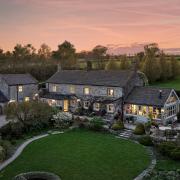For generations visitors have been charmed by the wonders of Wetherby. Richard Darn is among them.

I always get a good vibe when visiting Wetherby. But I’ve never been able to put my finger on why I like the place so much. Then it dawned on me – I love the very stone the buildings are made from.
A glance at Historic England’s Stone Atlas of West and South Yorkshire (yes it exists!) tells me all I need to know. The exquisite white and yellow stone is magnesian limestone, quarried locally from a natural ridge that extends all the way down to Doncaster. This accounts for why places like Boston Spa and Hooton Pagnell have a similar likeness to Wetherby.
And they are keeping good company, for the same stone was used in the building of York Minster, the Houses of Parliament, and even found favour with the Romans when constructing Eboracum (York) and Aldborough.
The buildings themselves are also a delight, modest, but undeniably handsome. What a joy it is to see so much of the town’s historic fabric intact and now part of a big conservation area. No wonder Wetherby has featured among the top places to live in the UK.

The town’s register of listed buildings tells you much, featuring as it does pubs, milestone markers and bridges. For this has been a crossroads for centuries – a place where marauding Scots armies forded the River Wharfe and a key pitstop on the Great North Road coaching route in the 18th century (40 pubs serviced the trade).
You might think that such an old place should have a castle – and it once did. A fortress was built in 1140 to guard the river crossing from northern incursions, but it was torn down after a few years because it didn’t have planning permission from the King! The remains lay under a rather attractive block of exclusive waterside dwellings.
Visit on a Thursday and you can combine yet more history with retail therapy. A plaque in the town centre tells me that ‘Werrebys’ market charter was granted to the Knights Templar by Henry III in 1240. This band of hardcore Christian warriors was formed during the Crusades to protect pilgrims and were famed for their white mantles adorned with the red cross of St George. They had a big impact on Yorkshire, where they held more land than any other English county. Such was their wealth that Edward II, acting on orders from the Pope, eventually disbanded them, fearing their growing power.
Some knights were even imprisoned in York Castle. Since then the rumour mill has worked over-time on the whereabouts of the vast pots of gold they supposedly stashed away. But their most tangible legacy in these parts is the market itself and a stained glass window depicting one of the knights in a Templar chapel at Ribston, a few miles to the north.

Highlights of the town’s subsequent history include the English civil war, when a vast Parliamentarian and Scots army stayed here before the decisive Battle of Marston Moor in 1644, and prosperity through corn growing. During the First World War many local men fought with the Leeds Pals and suffered appalling loses (a beautiful winged Angel of Victory memorial is located on the main bridge) while a little known aspect of the 1939–45 conflict is the fact that many lumberjills were trained here to take over the vital job of timber production whilst the men were away fighting. And let’s not forget that enlisted US actor Clark Gable (star of the 1939 classic Gone with the Wind) was stationed at nearby RAF Marston Moor, as part of an American air-force detachment.
Strolling through Wetherby on a sunny day it’s plain to see the town has lost none of its ancient vitality. There’s hardly a vacant shop to be seen with plenty of choice including a splendid fishmonger and numerous pubs and cafes. Magnificent flower beds abound (the town has won accolades for its displays) and look out for a floral trail in the summer. Another date for the diary is the 42nd Wetherby Arts Festival from October 11–20, featuring the Leeds Symphony Orchestra, an assortment of literary and comic luminaries, plus walks and talks and even a festival fringe.
A life-time ago I spent many happy days in Wetherby as the family caravan was permanently sited a few miles away. So I can vouch for the town’s stunning hinterland, with gorgeous villages like Linton, Sicklinghall and Kirkby Overblow an easy bike ride away.
The town is also a perfect base for a walk, whether it’s a circular one embracing the splendid riverside scenery, or a relaxing blue plaque trail (18 locations are listed), available from the Tourist Information Centre.

One popular starting point is the River Wharfe where it tumbles over a weir, once the site of a watermill (one of the wheels can still be seen). Here a couple of leaping salmon are depicted in a lovely sculpture installed to celebrate the millennium. It’s also a reminder that iconic fish species are making a comeback to Yorkshire’s rivers.
Wetherby is the perfect size for a small market town and in the ideal location. It oozes charm and you will go a long way before finding a nicer place to while away a few hours, or even put down roots. Those templars knew a good thing when they saw it.





























